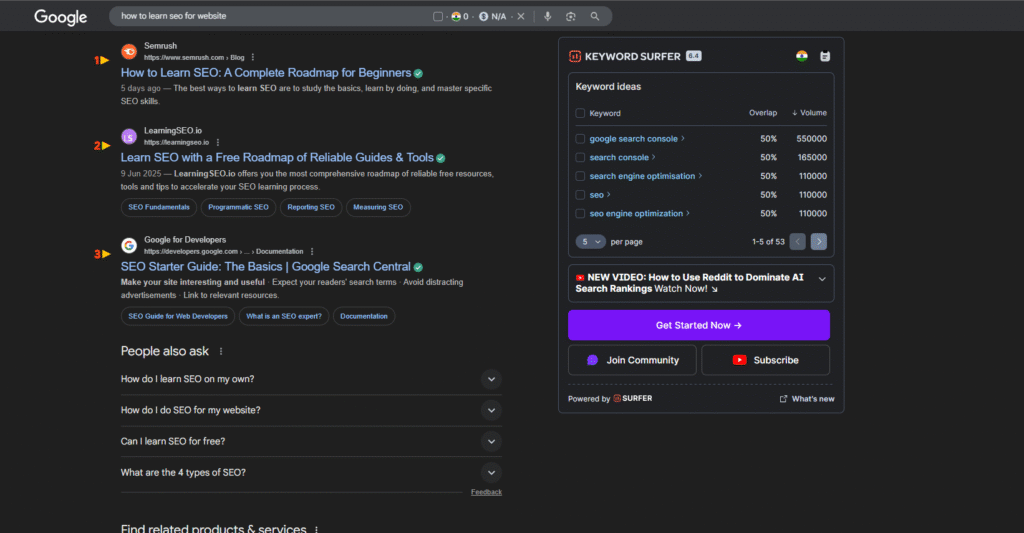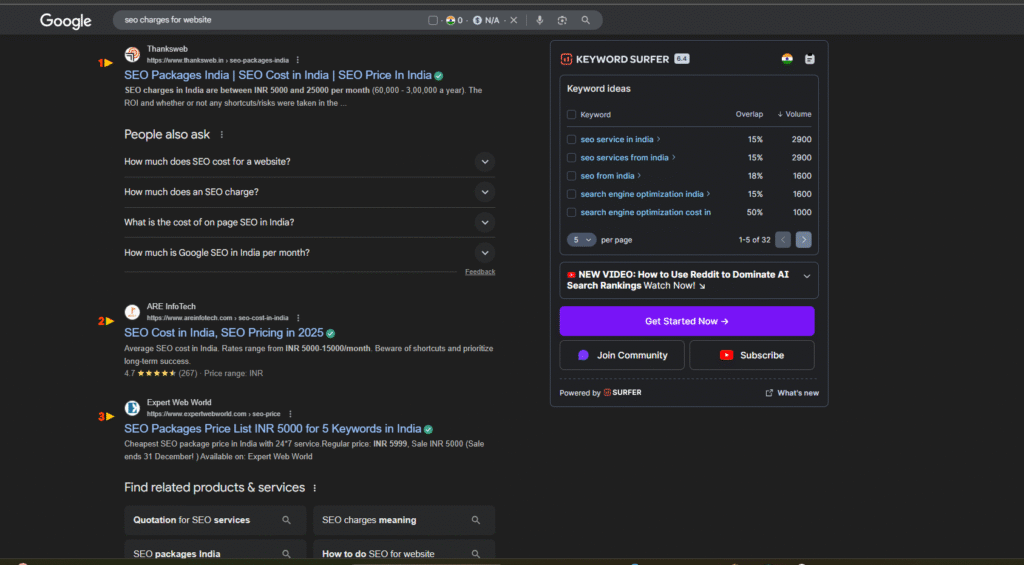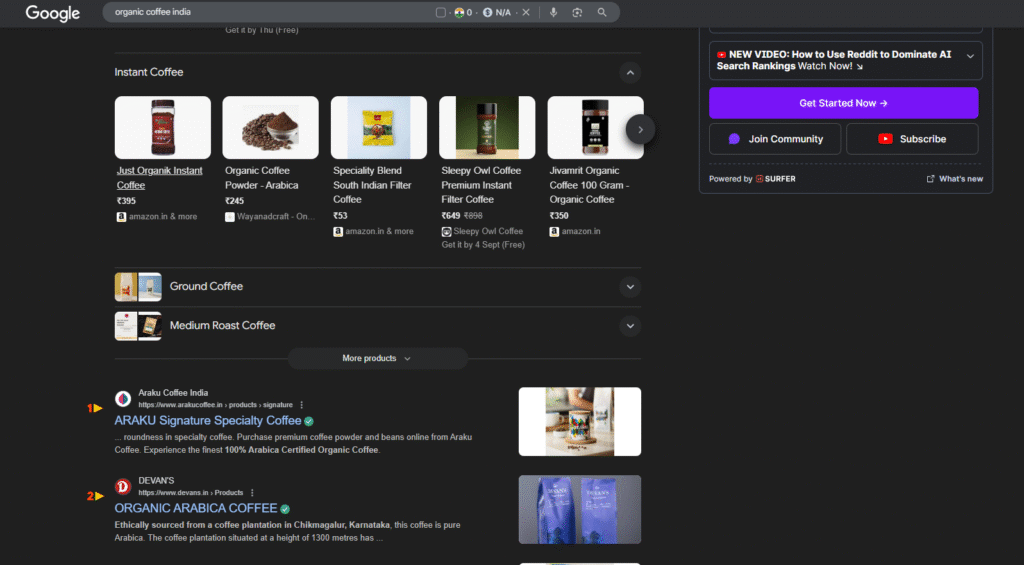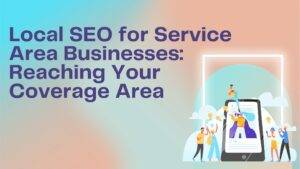What role does local intent play in Google SERPs?
Local search intent refers to the purpose behind a user’s query when they want information, products, or services connected to a specific geographic location. A person may be searching for something immediate, like a nearby coffee shop, or planning ahead by looking up restaurants to visit in another city, state, or country during an upcoming trip.
If you are starting to work with local businesses or managing a virtual brand that is opening its first physical outlet, understanding local search intent is key to reaching and serving your audience effectively.
What is Local Search Intent?
In SEO, search intent is usually divided into four main categories. Each applies to local searches as well:
Informational intent
Users want knowledge—basic or detailed. For example, they might search for the oldest landmark in their town, local building regulations for home additions, or how to create a garden suited to their city’s climate.

Commercial intent
Here, searchers are comparing options before buying. Queries could include “best phone carrier near me,” “cheapest running shoes in X city,” or “fastest laptops available locally.”

Transactional intent
These searchers are ready to act. Their searches may look like “organic coffee near me,” “buy running shoes in X city,” or “book a manicure today in X city.”

Navigational Intent
This type of intent comes from a searcher who is looking for a specific brand, business, or website rather than being open to general results. Their queries could look like: “HP laptop near me,” “phone number dr. jim wong,” or “order little caesar’s pizza.”

These examples highlight how local intent can appear across all four intent categories. When you test many of these types of searches, you’ll notice that Google often displays localized results, including the local pack. Google also adjusts organic listings when it detects local intent and may even generate localized AI Overviews that pull information directly from local sources.

Google’s objective is to deliver results that best satisfy the local intent behind a query. For local businesses, the marketing goal is to understand these intents and create digital assets that clearly show both Google and users that your business is the right fit for their local needs.

How to Optimize for Local Search Intent
A strong local SEO strategy ensures you have content for all four types of intent. This way, customers are guided through each stage of their journey—from learning more about a topic, to researching options, to making a purchase, and even finding a specific business or brand.
Since people may switch between different intents before making a final decision, your digital assets need to be ready to serve them at any stage of this process.
Four Ways to Meet Local Intents
1. Use Google Business Profiles (GBPs) effectively
One of the most direct ways to align with local search intent is by creating and verifying a Google Business Profile for each business location. Whenever a query includes “near me,” a city name, or any signal of local intent, Google is highly likely to display a local pack of results. Your eligibility for inclusion starts with having a properly set up GBP.
Competitors who fail to fully optimize their profiles give you an opportunity to stand out. To maximize visibility, enrich your GBP with:
- Photos showcasing your location, products, services, and features such as affordability, quality, or convenience.
- Videos explaining how your offerings compare favorably with local alternatives.
- Product listings integrated through Google Merchant Center so your inventory is searchable.
- Business descriptions tailored to common customer intents (e.g., “largest selection of HP and Lenovo laptops in San Jose”).
- Reviews and responses that build trust, highlight professionalism, and showcase great service.
Using On-Page Website Content to Serve Local Intents
Your website’s multimedia content should be carefully structured and optimized to align with different user intents. But before you start writing, capturing photos, or producing videos, it’s important to research two key areas:
- Customer intent patterns – Use tools like keyword research platforms, surveys, polls, and other audience research methods to identify the language your community uses at different intent stages. For example, what phrases do they type in when they’re simply researching, and how does that differ from the queries they use when they’re ready to purchase?
- Google’s interpretation of intent – Take what you’ve learned from your audience research and examine what Google shows in the search results for those queries. For example, when searching “how to calculate my mortgage payment,” does Google display calculators, videos, articles, infographics, or podcasts? By studying these results, you can identify which formats Google considers the most relevant and tailor your on-page content accordingly.
Search intent (often called user intent) should always focus on the needs of the audience. With local intent, however, there’s an added layer: your content must consistently emphasize location. Every element—title tags, meta descriptions, headers, body copy, image alt text, video transcripts, and tools—should make it clear that your business is tied to a specific place.
You’re not just offering Italian family-style dining, late-night laundry, or same-day dental appointments—you’re providing these services in Chicago, Philadelphia, or San Francisco. Don’t rely on Google or potential customers to figure this out. Be explicit on every page about what you offer, where you are, and how people can access your products or services.
Off-Page Assets and Local Intents
In the early days of the web, meeting local search intent often meant simply having users click through to your website. Today, customer behavior is far more diverse, with people seeking local business details and recommendations from many different sources.
To go beyond on-page optimization, make sure your business is referenced in multiple places, such as:
- Local business directories besides Google, including Apple Business Connect, Yelp, YP.com, Facebook, or TripAdvisor
- Third-party “best of” lists in publications or platforms like Yelp’s city-specific roundups
- Social media platforms like Reddit, Instagram, Facebook, Nextdoor, and TikTok, where users often share local business recommendations
- Video platforms like YouTube, where you can upload your own content or collaborate with others
- Podcasts or vlogs related to your niche or geographic region
- Private groups and publishing platforms such as Discord, Substack, or Patreon communities with a local or industry focus
- City or industry-specific blogs
- Local news websites that feature business coverage
The more your business is mentioned across these platforms, the more likely potential customers are to discover you during different intent stages.
Optimizing Technical Elements
Beyond visibility, your website must deliver a seamless user experience. Technical issues can stop customers from converting, even if they’ve already decided to engage. Focus on:
- Store locators – Easy to find, accurate, and user-friendly. Enterprise-level businesses should use advanced locators that return real-time inventory and filters matching complex intents.
- Shopping carts – Keep the checkout process simple, clearly show fulfillment options (pickup, delivery, shipping), and be transparent about fees to avoid cart abandonment.
- Booking tools – Regularly test calendars and booking widgets to ensure smooth functionality and prevent lost conversions.
- Navigation menus – For smaller multi-location businesses without store locator tools, make sure each location page is easily accessible through your main site menus.
Measuring Local Search Intent Success
Tracking is critical to understanding whether your intent-focused content is working. For example, say a general contracting firm learns its community frequently searches for guidance on qualifying to add an ADU in their city or county. You might publish a detailed text guide and record your rankings before and after publishing, checking progress after several weeks or months. With promotion through link-building and social media, you should see visibility improvements for those queries.
If results fall short, reconsider your format—perhaps Google prefers a video tutorial or infographic for this query type. Maintaining an experimental mindset is essential. Combine analytics tools with customer feedback to refine your approach and produce the type of content people find most useful at different decision stages.
By monitoring metrics like SERP visibility, organic traffic, clicks-to-call, direction requests, dwell time, conversions, and sales, you’ll know when your optimization is successfully aligning with local search intent.
Frequently Asked Questions (FAQs)
1. What is local search intent?
Local search intent refers to the purpose behind a search query when a user is looking for information, products, or services in a specific geographic area. For example, someone searching “best pizza near me” is showing local search intent.
2. Why is local search intent important for businesses?
Because it connects businesses directly with nearby customers who are actively searching for their products or services. Optimizing for local intent helps increase visibility, foot traffic, and conversions.
3. What are the main types of search intent?
The four primary types are:
- Informational – looking for knowledge
- Commercial – comparing options before purchasing
- Transactional – ready to make a purchase or booking
- Navigational – looking for a specific business, brand, or site
4. How can I optimize my website for local search intent?
Include your location throughout your on-page content, optimize title tags, meta descriptions, headers, images, and videos with local keywords, and ensure your Google Business Profile and other listings are accurate and complete.
5. What off-page strategies help with local search intent?
Getting your business listed on local directories, appearing in “best of” articles, being active on social media, publishing videos, and gaining coverage in local blogs or news outlets can all strengthen visibility for local queries.
6. How do I measure success in local intent optimization?
Track your rankings for local keywords, clicks-to-call, requests for directions, conversions, customer reviews, and overall website traffic from local searches to measure performance.
7. Does Google treat local intent differently from general search intent?
Yes. Google customizes search results for queries with local intent by showing local packs, map results, and location-based organic results tailored to the user’s area.
8. What role does Google Business Profile play in local search intent?
A fully optimized Google Business Profile helps your business appear in local packs and maps when users search with geographic terms or “near me” phrases, making it one of the most important tools for local SEO.




